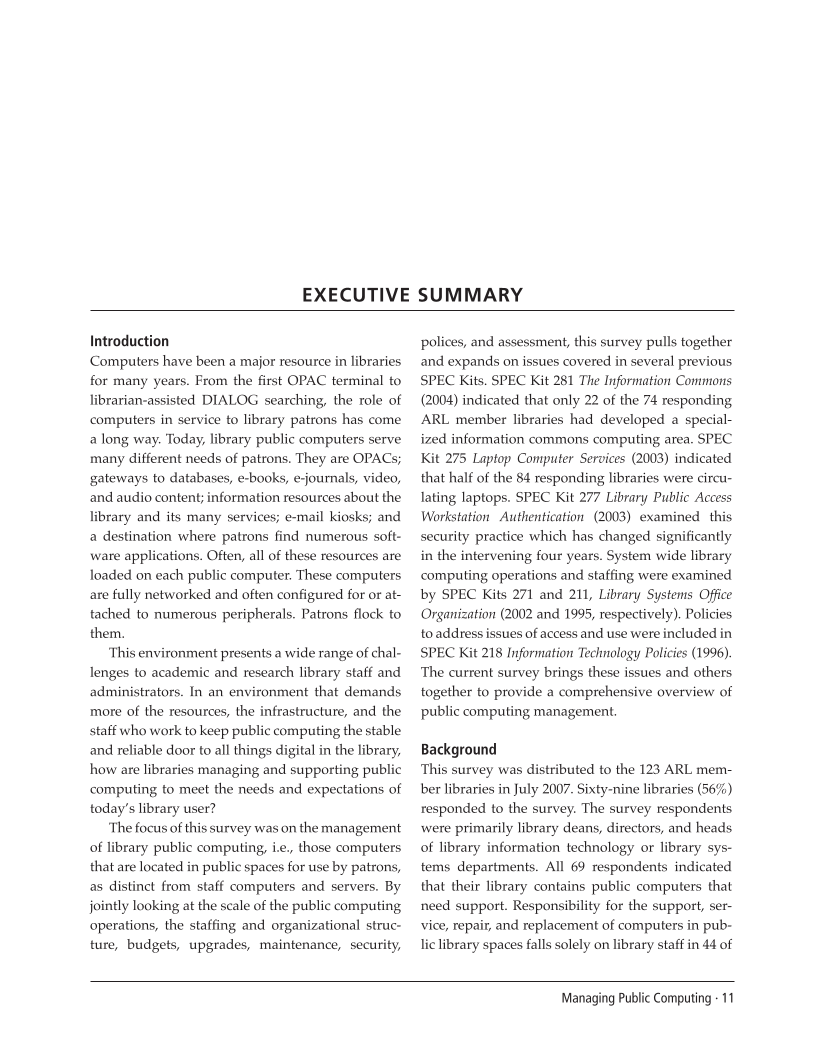Managing Public Computing · 11
Executive Summary
Introduction
Computers have been a major resource in libraries
for many years. From the first OPAC terminal to
librarian-assisted DIALOG searching, the role of
computers in service to library patrons has come
a long way. Today, library public computers serve
many different needs of patrons. They are OPACs
gateways to databases, e-books, e-journals, video,
and audio content information resources about the
library and its many services e-mail kiosks and
a destination where patrons find numerous soft-
ware applications. Often, all of these resources are
loaded on each public computer. These computers
are fully networked and often configured for or at-
tached to numerous peripherals. Patrons flock to
them.
This environment presents a wide range of chal-
lenges to academic and research library staff and
administrators. In an environment that demands
more of the resources, the infrastructure, and the
staff who work to keep public computing the stable
and reliable door to all things digital in the library,
how are libraries managing and supporting public
computing to meet the needs and expectations of
today’s library user?
The focus of this survey was on the management
of library public computing, i.e., those computers
that are located in public spaces for use by patrons,
as distinct from staff computers and servers. By
jointly looking at the scale of the public computing
operations, the staffing and organizational struc-
ture, budgets, upgrades, maintenance, security,
polices, and assessment, this survey pulls together
and expands on issues covered in several previous
SPEC Kits. SPEC Kit 281 The Information Commons
(2004) indicated that only 22 of the 74 responding
ARL member libraries had developed a special-
ized information commons computing area. SPEC
Kit 275 Laptop Computer Services (2003) indicated
that half of the 84 responding libraries were circu-
lating laptops. SPEC Kit 277 Library Public Access
Workstation Authentication (2003) examined this
security practice which has changed significantly
in the intervening four years. System wide library
computing operations and staffing were examined
by SPEC Kits 271 and 211, Library Systems Office
Organization (2002 and 1995, respectively). Policies
to address issues of access and use were included in
SPEC Kit 218 Information Technology Policies (1996).
The current survey brings these issues and others
together to provide a comprehensive overview of
public computing management.
Background
This survey was distributed to the 123 ARL mem-
ber libraries in July 2007. Sixty-nine libraries (56%)
responded to the survey. The survey respondents
were primarily library deans, directors, and heads
of library information technology or library sys-
tems departments. All 69 respondents indicated
that their library contains public computers that
need support. Responsibility for the support, ser-
vice, repair, and replacement of computers in pub-
lic library spaces falls solely on library staff in 44 of
Executive Summary
Introduction
Computers have been a major resource in libraries
for many years. From the first OPAC terminal to
librarian-assisted DIALOG searching, the role of
computers in service to library patrons has come
a long way. Today, library public computers serve
many different needs of patrons. They are OPACs
gateways to databases, e-books, e-journals, video,
and audio content information resources about the
library and its many services e-mail kiosks and
a destination where patrons find numerous soft-
ware applications. Often, all of these resources are
loaded on each public computer. These computers
are fully networked and often configured for or at-
tached to numerous peripherals. Patrons flock to
them.
This environment presents a wide range of chal-
lenges to academic and research library staff and
administrators. In an environment that demands
more of the resources, the infrastructure, and the
staff who work to keep public computing the stable
and reliable door to all things digital in the library,
how are libraries managing and supporting public
computing to meet the needs and expectations of
today’s library user?
The focus of this survey was on the management
of library public computing, i.e., those computers
that are located in public spaces for use by patrons,
as distinct from staff computers and servers. By
jointly looking at the scale of the public computing
operations, the staffing and organizational struc-
ture, budgets, upgrades, maintenance, security,
polices, and assessment, this survey pulls together
and expands on issues covered in several previous
SPEC Kits. SPEC Kit 281 The Information Commons
(2004) indicated that only 22 of the 74 responding
ARL member libraries had developed a special-
ized information commons computing area. SPEC
Kit 275 Laptop Computer Services (2003) indicated
that half of the 84 responding libraries were circu-
lating laptops. SPEC Kit 277 Library Public Access
Workstation Authentication (2003) examined this
security practice which has changed significantly
in the intervening four years. System wide library
computing operations and staffing were examined
by SPEC Kits 271 and 211, Library Systems Office
Organization (2002 and 1995, respectively). Policies
to address issues of access and use were included in
SPEC Kit 218 Information Technology Policies (1996).
The current survey brings these issues and others
together to provide a comprehensive overview of
public computing management.
Background
This survey was distributed to the 123 ARL mem-
ber libraries in July 2007. Sixty-nine libraries (56%)
responded to the survey. The survey respondents
were primarily library deans, directors, and heads
of library information technology or library sys-
tems departments. All 69 respondents indicated
that their library contains public computers that
need support. Responsibility for the support, ser-
vice, repair, and replacement of computers in pub-
lic library spaces falls solely on library staff in 44 of






















































































































































































